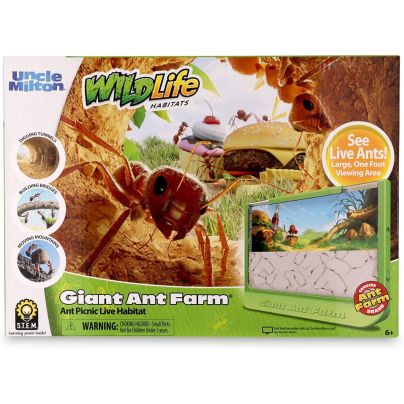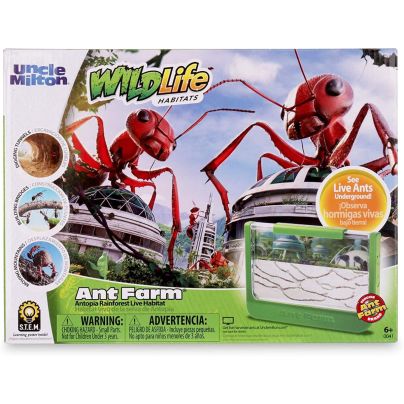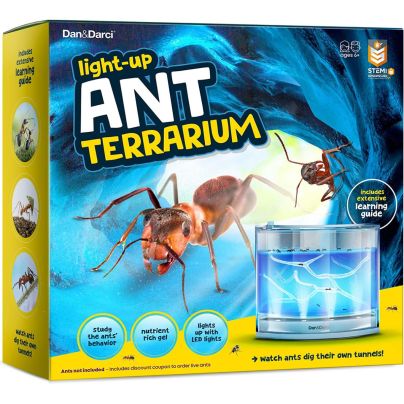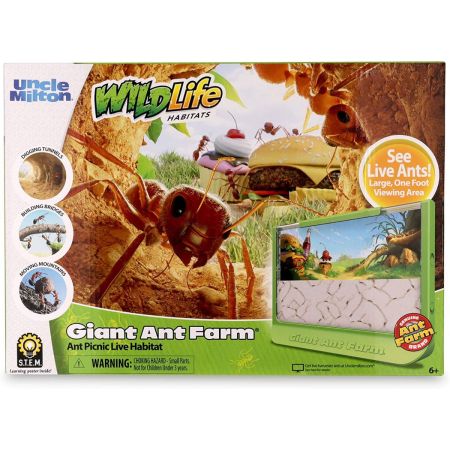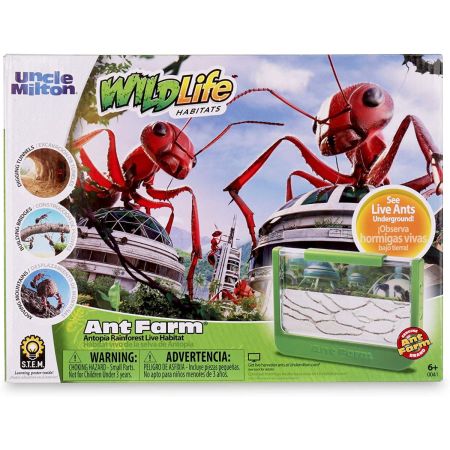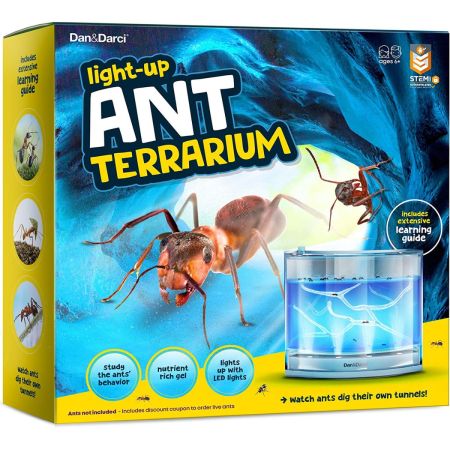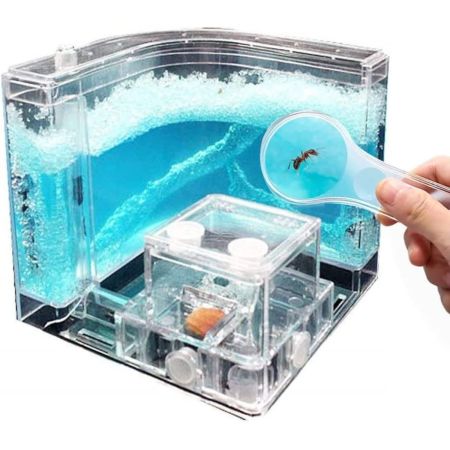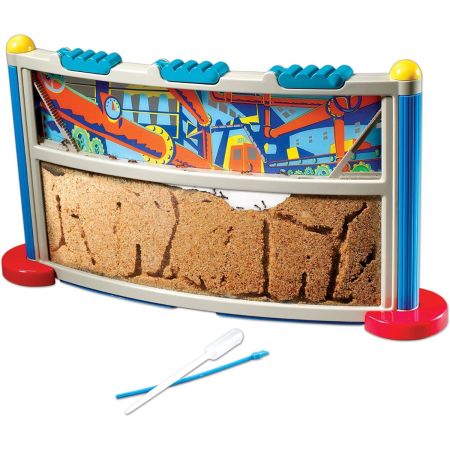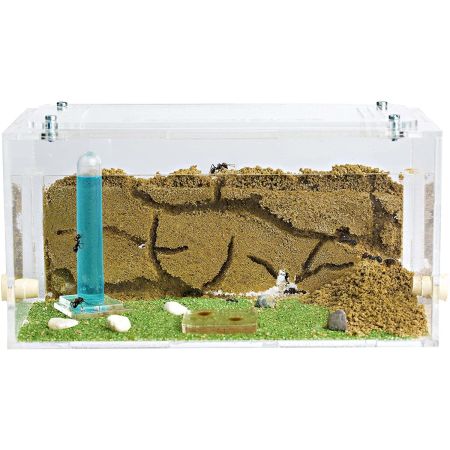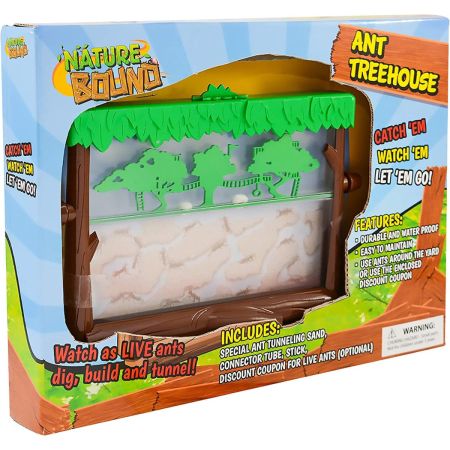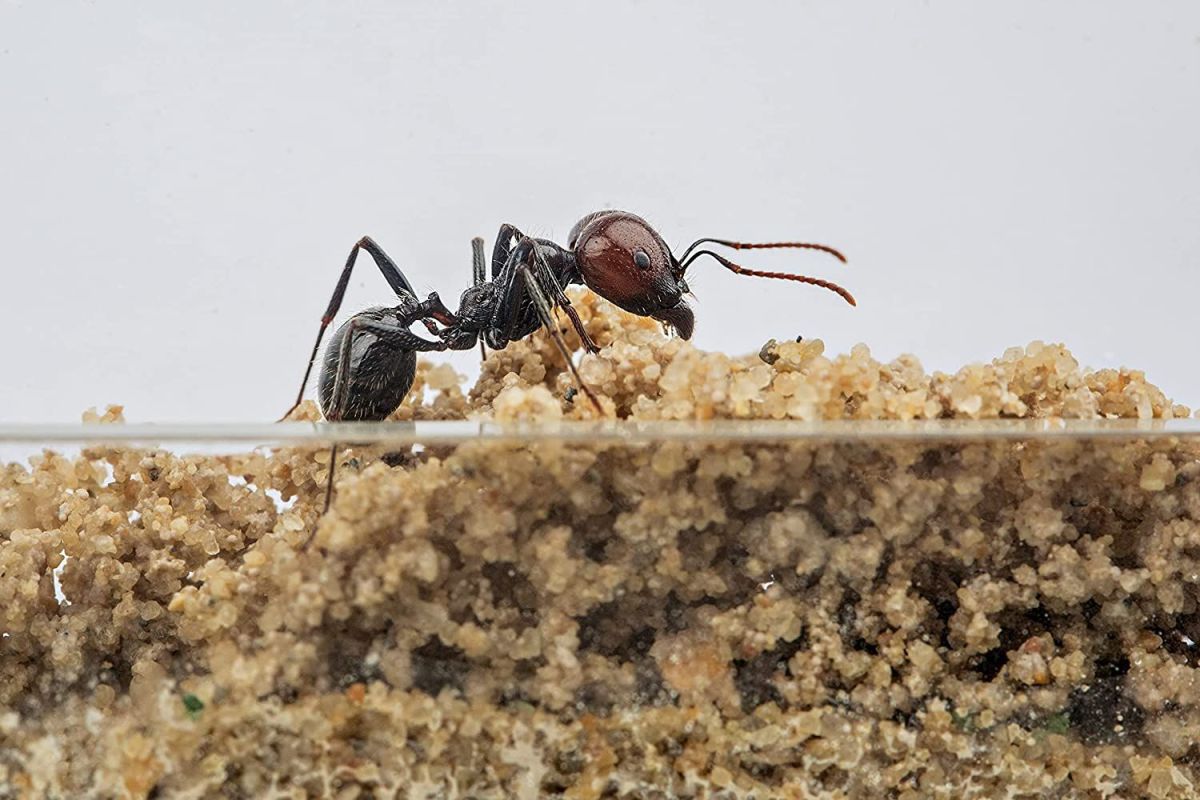
We may earn revenue from the products available on this page and participate in affiliate programs. Learn More ›
Keeping an ant farm is a rewarding pastime for children and adults. Formally known as a formicarium, these fascinating habitats make owning and observing an ant colony accessible. Young kids in their “bug phase” can learn a lot from a well-designed ant farm, while parents and teachers will feel secure that the unit will be easy to care for with little chance of escapees. A good ant farm provides a safe and secure environment for the insects, so they can thrive while staying firmly contained in the enclosure. Keep reading to find out what to look for in formicaria and read descriptions of the best ant farms for budding entomologists and insect hobbyists.
- BEST OVERALL: Uncle Milton Giant Ant Farm
- BEST BANG FOR THE BUCK: Uncle Milton Ant Farm Antopia Rainforest Ant Habitat
- BEST WITH LIGHTING: Dan & Darci Light-Up Ant Habitat
- BEST SMALL: Navadeal Blue Gel Ant Castle Ant Farm
- BEST LARGE: Educational Insights GeoSafari Ant Factory
- BEST FOR ADULTS: Anthouse 3D Starter Kit
- ALSO CONSIDER: Nature Bound Toys Ant Treehouse Habitat Kit
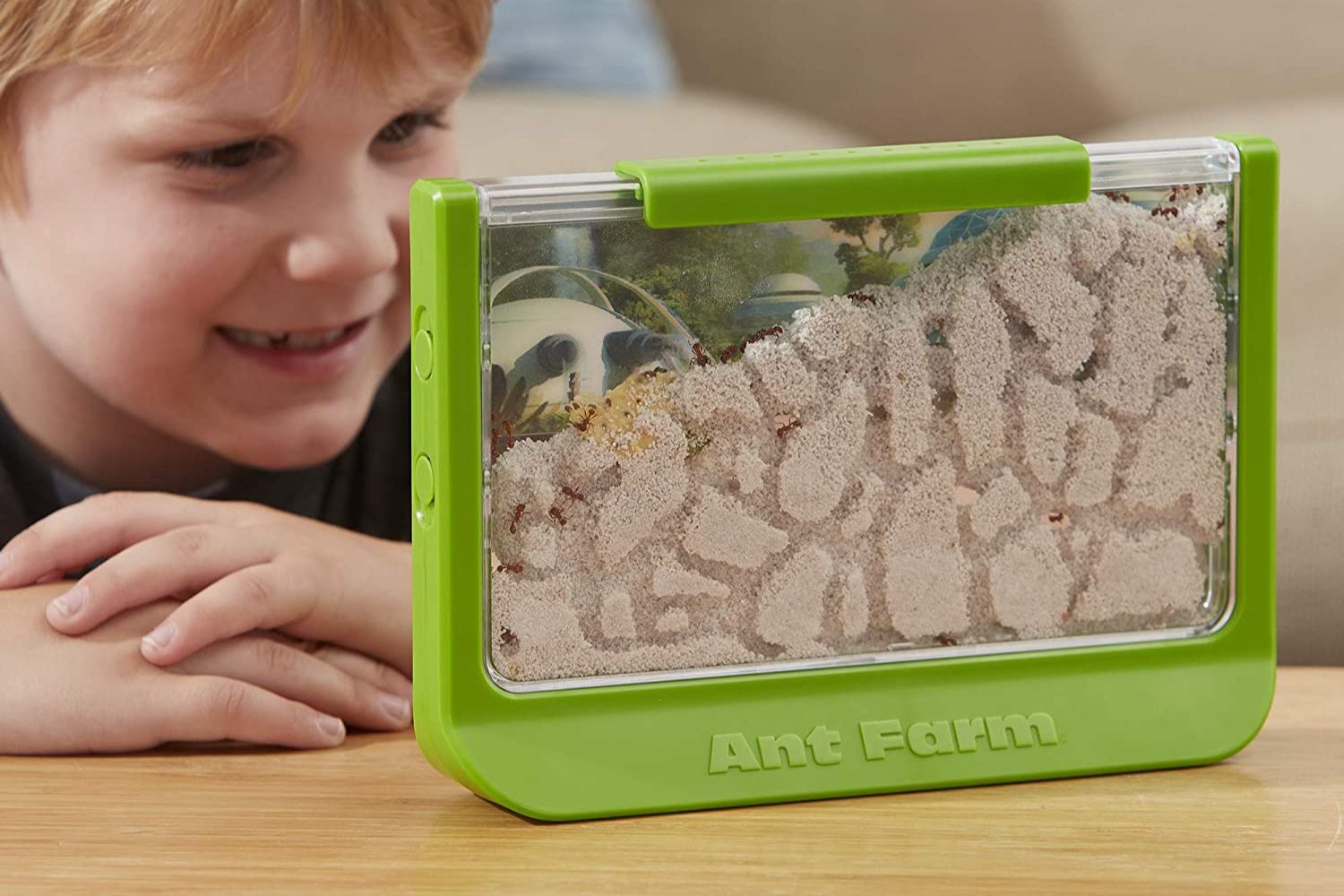
What to Consider When Choosing the Best Ant Farm
Ant farms consist of a nest layer, a landscape layer, and a containment layer. The nest layer, also called the filler or substrate layer, is the heart of the community. The landscape layer, which lies in the above-ground area, is where the ants scavenge for food and eliminate waste.
The critical containment layer keeps the ants from escaping the ant farm. It is a physical layer (such as a sealed but openable lid) that can also incorporate nontoxic deterrents such as petroleum jelly, talcum powder, or oil to further deter ants from escaping.
In a good ant farm, all three layers will be suitable for its inhabitants. The filler substrate will be ample enough, with space at the top for ants to move in and out of as they bring in food and remove waste. Specific features to consider when choosing a good ant enclosure include design, size, and, of course, the ant population itself.
Design
The two basic types of ant farms are terrarium style and sandwich style. Terrarium-style ant farms are essentially a container filled with substrate, often topped with a layer of landscaping foliage or decoration. These ant farms can create wonderful environments for ant colonies, with secure and private areas suitable for housing a queen ant. However, these containers are often pretty wide and deep, so they won’t offer as many opportunities for observation.
Most ant farms on the market, especially those that cater to kids, are sandwich style. These vertical ant farms are designed to make it easy to view the ants. They usually involve two panels of glass or plastic, sandwiching a thin layer (about an inch or two) of substrate. These ant farms aren’t suitable for housing a queen, however, because of their lack of seclusion, but they can’t be beat for observation.
Either type of ant farm can include added aesthetics for human entertainment, such as natural hardscaping on the surface or plastic decorations to add interest to the top layer, which are especially amusing for kids.
Filler
There are several filler or substrate types used in ant farms, including sand, soil, and gel. Traditionally, sand is the most popular filler because it provides a great environment for ants, and the light color offers an excellent contrast to keep the colony visible. One downside of a sand ant farm is that it shouldn’t be moved once it’s set up because motion can cause the tunnels to collapse. Sand ant farms last longer than gel options but require more work because food and water must be provided for the colony.
Gel ant farm substrates, also popular in sandwich-style enclosures, rely on a specially formulated artificial substance that ants can nest in and subsist on. The nutrient-rich edible gel typically contains enough moisture and food to sustain the ants, so upkeep is minimal. (Only cleaning is required.) The gel is often brightly colored, making it attractive to kids; the color also makes it easy to see the ants within. Unlike sand, gel doesn’t run the risk of collapsing when the farm is moved. However, replacement gel isn’t widely available, which means most gel ant farms last only for the life cycle of the ants.
Soil is an excellent natural option for ants. It’s rarely used in sandwich-style ant farms because of low visibility, but it’s great for terrariums because ants can find additional nutrients from certain soil mixtures, and any live foliage can benefit from nutrients in the soil as well.
Size
Most sandwich-style ant farms are relatively small, designed to be placed on a desktop or bedroom shelf. The owner will want to first choose a location for the ant farm to determine an ideal size. This step is especially important for sand-filled ant farms because they shouldn’t be moved once placed.
Also consider the viewing area. A larger ant farm means a larger viewing area, and vice versa. Ant farms are usually bought for entertainment and educational purposes, so shoppers will want a large enough viewing area.
For more flexibility (and to create a more distinctive enclosure), some ant farms allow users to add to the enclosure using small tubes to connect it to other ant farms.
Ant Population
Perhaps surprisingly, most ant farms do not include ants! The few that do are often shipped with red harvester ants, one of the most common species used in ant farms. If the ant farm does not include ants, buyers will have to provide them on their own.
Fortunately, it’s easy enough to purchase ants through an online or local retailer. Many ant farms include recommendations for suitable ant types, the number of ants that can safely live in the enclosure, and sometimes reliable sources from which to buy ants. A few brands even offer a voucher to order free or discounted ants from suppliers.
Generally, suppliers will sell only worker ants because in many areas, it’s illegal to supply queens to avoid accidentally introducing non-native invasive ant species into another area. Queen ants have the ability to start a new colony, which can disrupt the ecosystem. Harvester ants don’t reproduce without a queen, which means they can’t repopulate.
Additional Features
Some ant farms come with a few accessories, such as food, filler material, magnifying glasses, tunnel-starter tools (small rods that create holes for ants to start tunneling), and connector tubes (to join multiple ant farms together). Included books or guides about ants can make the ant farm even more educational.
Created with kids in mind, many ant farms are made with break-resistant materials and feature a childproof lock. These features are a must-have for younger children to prevent any broken enclosures and ant escapees. However, they can also benefit older children and adult users to keep the enclosure protected. For even more security, some also have a self-locking feature, locking automatically when the lid is closed to keep little hands out—and ants in.
LED lighting is a fun extra feature that can appeal to ant enthusiasts of all ages. Light-up ant farms enable users to observe ants day or night.
Our Top Picks
The best ant farms ahead make it easy and fun to get up close and personal with ants.
Best Overall
Uncle Milton Giant Ant Farm
Uncle Milton is the brand behind the original highly popular ant farm for kids, Uncle Milton’s Ant Farm, introduced in 1956. The Uncle Milton Giant Ant Farm is a larger, newer iteration of the classic, with about double the viewing area compared with its predecessor. This kit includes a sizable habitat with four connection ports, two bags of tunneling sand, a tunnel-starter tool, one connector tube, and a guide with a code for ordering harvester ants.
The ant farm measures 9.25 inches tall by 13 inches wide by 2.5 inches deep. It is made of break-resistant materials and has an escape-proof and tip-resistant design. A sliding feeding cap along the top makes it easy to put in food and water without risk of ants escaping. Ants aren’t included, but this kit does include a voucher for free ants.
Product Specs
- Filler: Sand
- Size: 9.5 inches tall by 13 inches wide by 2.5 inches deep
- Ants included: No, but a voucher for free ants is included
Pros
- Large viewing area
- Break-resistant and escape proof
- Tip-resistant stand
- Includes filler sand and voucher for free ants
Cons
- Difficult to clean due to small slide top
Get the Uncle Milton Giant ant farm on Amazon.
Best Bang for the Buck
Uncle Milton Ant Farm Antopia Rainforest Ant Habitat
Uncle Milton Ant Farm Antopia Rainforest Ant Habitat is another new take on the original, with a few new perks and decorations. It measures 6.25 inches tall by 9.8 inches wide by 1.25 inches deep, so although it has a smaller viewing area, its smaller footprint enables a more affordable price.
This kit includes an ant-farm habitat with four connection ports, two bags of tunneling sand, a tunnel-starter tool, one connector tube, and an ant guide with a voucher for harvester ants. It’s also break- and tip-resistant as well as escape proof, with a sliding top to drop in food and water without needing to open the entire container. This ant farm includes a voucher for free ants, adding even more value to its affordable price.
Product Specs
- Filler: Sand
- Size: 6.25 inches tall by9.8 inches wide by 1.25 inches deep
- Ants included: No, but voucher for free ants is included
Pros
- Budget-friendly
- Break-resistant and escape proof
- Includes filler sand and voucher for free ants
Cons
- Difficult to clean because of the small slide top
Get the Uncle Milton Antopia ant farm on Amazon.
Best with Lighting
Dan u0026 Darci Light-Up Ant Habitat
LED lighting can add even more visual interest to an ant farm, not to mention make it possible to watch ant activity into the evening. The Dan & Darci Light-Up Ant Habitat features a prefilled blue gel that emits an appealing glow when the LED light base is switched on. The nutrient-rich gel sustains the ants as they burrow deep inside and create tunnels.
This kit includes a light-up ant habitat, magnifying glass, USB power cable, tunnel-starter tool, learning guide, and a voucher for discounted live ants. The ant habitat measures 5.75 inches tall by 6.5 inches wide—an average size. There’s no battery required, so lighting this ant farm is simple: Just plug it into an outlet and observe.
Product Specs
- Filler: Gel
- Size: 5.75 inches tall by 6.5 inches wide
- Ants included: No, but includes a voucher for discounted ants
Pros
- LED lighting
- Plug-in power; no batteries required
- Low maintenance
Cons
- Short power cable
Get the Dan & Darci ant farm on Amazon or Dan & Darci.
Best Small
Navadeal Blue Gel Ant Castle Ant Farm
The Navadeal ant farm fits plenty of opportunities for ant viewing in a small package. This kit includes a prefilled gel ant habitat, a magnifying glass, a plastic pipette, plastic tweezers, and cotton pads for feeding and watering the ants. The habitat measures 4 inches tall by 4.25 inches wide by 4.25 inches deep, making it the ideal size for a desktop or small shelf.
This two-section habitat features a back area with a translucent blue gel for ants to nest and a detachable front section with feeder holes for providing food and water. Although the gel is nutrient rich to sustain the ants, adding food can make viewing the habitat more entertaining. On the gel section, the top cap is removable for easy cleaning.
Navadeal also manufactures a sand version of this ant farm for those who prefer a sand filler. With two connection points on each ant farm, users can create a larger, sprawling enclosure to hold more ants.
Product Specs
- Filler: Gel
- Size: 4 inches tall by 4.25 inches wide by 4.25 inches deep
- Ants included: No
Pros
- Small footprint
- 2 sections for more observation space
- Easy to clean
Cons
- Can only house a few ants (about 10 to 15)
Get the Navadeal ant farm on Amazon or Navadeal.
Best Large
Educational Insights GeoSafari Ant Factory
A larger ant farm means more space for ants, more ant activity, and more viewing area. For serious ant enthusiasts or classroom use, the Educational Insights GeoSafari Ant Factory is an extra-large model, perfect for multiple observers. Measuring 9 inches tall by 15 inches wide, it offers plenty of viewing area to see ants at work.
It’s durable, escape proof, and tip-resistant. With three top openings, it’s easy to drop food and water into the enclosure—although their small size can make it difficult to clean the farm. This kit includes a large ant-farm habitat, tunnel-starter tool, a dropper, and a voucher for free harvester ants. Filler sand is not included.
Product Specs
- Filler: Sand
- Size: 9 inches tall by 15 inches wide
- Ants included: No, but voucher for free ants is included
Pros
- Very large viewing area
- Tip-resistant base
- Includes voucher for free ants
Cons
- Filler sand not included
- Can be difficult to clean
Get the Educational Insights ant farm on Amazon or Educational Insights.
Best for Adults
Anthouse 3D Starter Kit
Many ant farms are designed with kids in mind, featuring fun but childish designs. Those looking for a more adult-friendly ant farm should consider the Anthouse ant farm. Not only does it omit some of the cartoonish elements of children’s ant farms, it also has a distinctive design, combining elements of a terrarium-style and sandwich-style ant farm.
Overall, this acrylic ant farm measures 3.94 inches tall by 7.87 inches wide by 3.94 inches deep. The back section is a sandwich-style enclosure that should be filled with the included sand to create a nest space. The front section resembles a small tank, with accessories to feed and water ants, and gives the insects room to explore and scavenge.
In addition to the ant farm, this kit includes various accessories to get started, including a small feeder (with liquid food mix) and water bowl, a plastic pipette, filler sand, and decorative stones.
Product Specs
- Filler: Sand
- Size: 3.94 inches tall by 7.87 inches wide by 3.94 inches deep
- Ants included: No
Pros
- Unique design
- Adult-friendly decorations
- Durable
Cons
- Pricey
Get the Anthouse ant farm on Amazon.
Also Consider
Nature Bound Toys Ant Treehouse Habitat Kit
The Nature Bound Toys Ant Treehouse Habitat Kit is another fun option designed with children in mind. It’s a sandwich-style sand-filled ant farm that measures 6 inches tall and 9 inches wide to provide a decent viewing area. Included in this set is the ant farm, a connector tube to join two or more ant farms, a feeding stick, filler sand, and a coupon for discounted live ants.
This ant farm features a treehouse theme, with branch and leaf designs. A treehouse decal inside the enclosure gives more space for ants to climb on and adds a bit of variety for the ants and their observers. The extra attention paid to decoration makes this ant farm an excellent gift for kids.
Product Specs
- Filler: Sand
- Size: 6 inches tall by 9 inches wide
- Ants included: No
Pros
- Fun tree-house theme
- Great for gifting
- Affordable
Cons
- Small top opening
- Difficult to clean
Get the Nature Bound Toys ant farm on Amazon or Nature Bound Toys.
Our Verdict
With a large viewing area and tip- and break-resistant design, the Uncle Milton Giant ant farm is the best ant farm for most kids. The Uncle Milton Antopia ant farm comes in a close second because of its affordable price and similar tip- and break-resistant design, just in a much smaller size.
How To Make a DIY Ant Farm
A simple sandwich-style ant farm is easy to put together with the right materials. Start with two jars: one large clear jar and one small jar. The small jar should be just an inch or two shorter than the large jar. It should be small enough in diameter to fit into the large jar, with about an inch of space around each side. Place the small jar (with its lid on) inside the large jar.
Create a soil-and-sand mixture using two parts soil and one part sand. This will create a substrate moist enough to keep its shape while ants dig and tunnel. Fill the space in between the jars with the soil-and-sand mixture. Keep the dirt loose and leave at least an inch of space at the top of the jar.
Puncture very tiny holes into the lid of the large jar using an awl or small knife. Make sure the holes aren’t large enough to allow ants to escape. Obtain about 20 ants (either from outside or from a retailer). Carefully place them in the jar, tightly screw on the lid, and enjoy your DIY ant farm!
How We Chose the Best Ant Farms
Ants are often viewed as pests. (Let’s face it: If you have a pack of biting fire ants in the garden, you’ll want to know how to get rid of fire ants). But the best ant farms can bring the curiosity and wonder about these tiny, hardworking insects back into perspective, especially for children who love bugs.
Of course, for adults, one of the most important considerations is that the ants are safely contained, so our top priority for these picks was a secure enclosure. Added features to keep ants inside were a bonus, such as small openings for food and water so it wouldn’t be necessary to take the ant farm apart. We chose ant farms that were highly rated for their ability to keep ants contained.
Besides security, we also looked for an attractive design and a substantial viewing area (relative to the overall ant-farm size). We prioritized ant farms that included accessories, such as tools to help provide food and water, filler materials, tunnel-starter tools, and especially vouchers for free or discounted ants to make getting started a user-friendly experience.
FAQs
Keeping an ant farm is a fun and educational pastime for insect hobbyists. They’re low maintenance and an excellent learning opportunity for kids. However, choosing to have an ant farm in the house always opens owners up to the risk of escape and possible infestation. In the case of any mishaps, keep this easy homemade ant trap in mind. Ahead are some more frequently asked questions and answers about keeping an ant farm.
Q. How can an ant farm owner get a queen ant?
Queen ants are not available for sale, so the best way to get a queen ant for starting an ant colony is to collect it from outside during mating season. Keep in mind that sandwich-style ant farms should not house a queen because they do not offer enough security and privacy.
Q. What kind of ants should be put in an ant farm?
Out of more than 12,000 species of ants, a handful of ant types are appropriate for ant farms. Harvester ants, black garden ants, and wood ants are the best species for these enclosures.
Q. How long does an ant farm last?
A typical ant farm without a queen will last about 3 to 4 months.
Q. What do ants like to eat?
Ants aren’t picky; they’ll eat almost anything! Some ant farms come with ant food or a list of food recommendations. Live or freshly killed bugs, fruit, meats, and honey and water soaked into a cotton ball are all options.
Q. Are ant farms hard to maintain?
No, ant farms are pretty easy to maintain. Owners will need to clean the ant farm periodically, and depending on the type, they may also need to place food and water occasionally in the enclosure.
Q. What should ant farmers do when the insects die?
Live ants will move any dead ants out of the nest, usually creating an area on the landscape layer to pile their dead. Then owners can remove the dead ants as necessary, discarding them outdoors.
